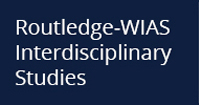
I have a background in global environmental change. Roughly a decade ago, when I was first acquainted with climate change concepts, I started trying to verify information and gather evidence. At that time, even though a consensus had been already established among members of the scientific community regarding climate change (IPCC 2022), several debates persisted at societal and political circles, hindering the access of the public to the growing body of evidence. Since at that time daily life was not being immediately impacted by climate change, people were unable to comprehend the ongoing changes and their potential impacts. Therefore, initially, I mainly focused on conducting evidence-based research on climate change, using specifically satellite observations to detect and analyze changes on large scales. After thorough investigations, I was able to gather substantial evidence that, compared to changes in historical settings, contemporary changes, including the melting of glaciers at the poles, rising sea levels, and global warming, are indeed exceptional. In the last few years, the effects of climate change have started to impact daily life too through extreme heat and drought during summer, extreme precipitation events, floods, etc.; hence, people are beginning to feel—and pay more attention to—the effects of climate change.
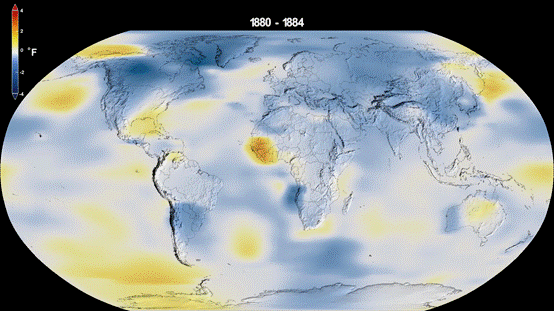
Figure 1: Dynamic Mapping of GLOBAL LAND–OCEAN TEMPERATURE INDEX Data source: NASA’s Goddard Institute for Space Studies Source: NASA/GISS https://data.giss.nasa.gov/gistemp/
Based on these initial explorations, the core of my current research comprises two important tasks: One is to determine which measures can be effective in relation to mitigating climate change; the other is to explain the relevant phenomena and convey the necessity of taking effective climate action to policymakers and the general public. This second task requires interdisciplinary efforts and cooperation.
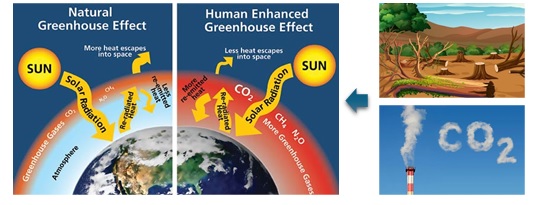
Greenhouse Effect vs. Global Warming: The primary challenge is the unprecedented CO2 concentration levels in the atmosphere, which are driven by human activities such as fossil fuel burning. This issue is further exacerbated by the decline of natural carbon sinks such as forests, which have undergone significant losses in recent decades, and their capacity to effectively sequester carbon has been significantly reduced (Kang et al., 2024).
Uncertainties and Challenges in Carbon Estimation
Accurately assessing carbon emissions and clearly defining emission reduction tasks that are closely linked to achieving carbon neutrality, especially at the community and regional levels, are among the top concerns for policymakers. Currently, carbon budget estimation is primarily performed using a bottom-up approach, which requires compiling emission inventories from various sectors, such as transportation, electricity, industry, and others, including land use and waste. Such an approach assesses emissions from human activity sources based on specific functions by referring to activity data and emission factors. The development of specific emission reduction policies for different sectors has been based on such bottom-up approaches (IPCC, 2022). However, such emission inventory estimates may involve considerable uncertainties when emission processes are difficult to quantify, as is often the case with land use, land use change, and waste, or when activity data are inaccurate or unavailable. As an alternative approach, my research adopts a top-down approach. Such approaches have undergone rapid development in recent years and include inferring CO2 concentrations in the atmosphere from satellite observations. Besides, a bottom-up approach cannot effectively capture the flows and interactions among different sectors, including exchanges with natural systems. Alternatively, a top-down observation approach provides insight into these interactions and offers a way to verify existing bottom-up estimates (Kang et al., 2024).
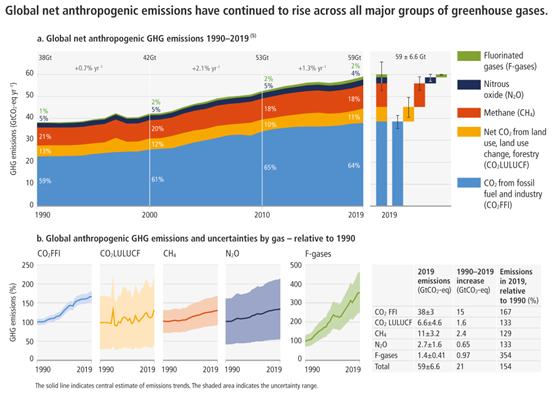
Figures from the 2022 IPCC Sixth Assessment Report: Global net anthropogenic greenhouse gas (GHG) emissions (GtCO2-eq yr-1) 1990–2019. Global net anthropogenic GHG emissions include the following: CO2 from fossil fuel combustion and industrial processes (CO2-FFI); net CO2 from land use, land use change, and forestry (CO2-LULUCF)8; methane (CH4); nitrous oxide (N2O); fluorinated gases (HFCs; PFCs, SF6, NF3).5. Source: https://www.ipcc.ch/report/ar6/wg3/figures/summary-for-policymakers/figure-spm-1
Understanding Land Use and Carbon Dynamics in Climate Mitigation
Land use and land use change are among the largest sources of uncertainty in the global carbon budget (IPCC, 2022). Land use refers to how people utilize and manage land, which typically includes forests, water bodies, farmland, urban built-up areas, grasslands, and wetlands. CO2 in the atmosphere undergoes exchanges and interactions with land reservoirs constantly depending in each case on the land category. Some of these land categories, such as urban land, where human activities primarily occur, act as carbon sources, whereas others, such as forests, act as carbon sinks. Furthermore, certain land categories, such as farmland, may become either carbon sources or sinks depending on the season and conditions. Climate change mitigation focuses on how to reduce excess greenhouse gases in the atmosphere, primarily CO2, through technological innovations and policy measures. This is crucial because CO2 has a long atmospheric lifetime of the order of hundreds of years, which means that once it is emitted into the atmosphere, it is difficult to eliminate.
My current research falls within the scope of nature-based solutions (NbS), which involve using natural resources as carbon sinks to capture, absorb, and remove atmospheric CO2. Even though such solutions have been already applied to a certain extent, conclusive evidence regarding their potential benefits and challenges are still lacking. In fact, climate–land interactions involve complex and nonlinear processes that include both the inherent impacts within natural systems and their close relationships with social systems (governance systems, policy, etc.). Therefore, my main aim in this project is to use multi-source observational data to conduct empirical research, focusing on examining and identifying the nonlinear relationships between carbon emissions and different land use/land policies to assess the effectiveness and potential challenges of mitigation methods related to land policies.
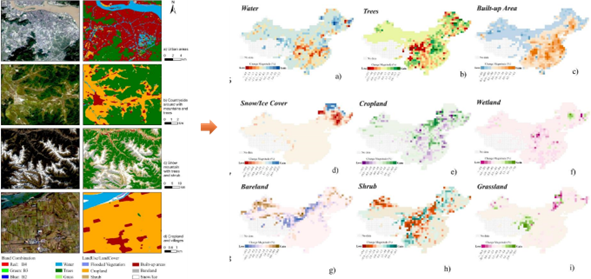
Mapping of land use/land cover changes and carbon dynamics in Mainland China. Quantifying land use/land cover changes from 2016 to 2019 using Sentinel-2 satellite data and Deep Learning techniques on the Google Earth Engine cloud computing platform (Kang et al., 2024).
Quantifying Nonlinear Relationships to Reduce Uncertainty
The current work aims to quantify the relationships between different land uses and land use changes and CO2. These relationships are usually nonlinear both spatially and temporally. Specifically, the nonlinear relationships illustrate how changes in different land use categories relate to CO2. Their quantified relationships should help us understand the extent to which an increase in the area of a certain land use category (i.e., the threshold) can serve as an effective carbon sink by absorbing a certain amount of CO2. Simultaneously, the results should also reveal the area decrease (i.e., the threshold) that will significantly weaken the carbon absorption capacity, leading indirectly to an increase in CO2. These area increases and decreases represent land use changes, i.e., the transition from one land use category to another.
On the one hand, with quantitative nonlinear relationships, we should be able to better understand the sources of uncertainty in the carbon budget; on the other hand, we should be able to formulate clearer and more effective land use policies based on these thresholds, such as how much forest area needs to be developed to result in a carbon sink effect. Overall, through this study, I aim to help establish feasible land use policies to support effective and equitable climate–land mitigation strategies within the framework of Earth system governance.

Nonlinear effects of tree cover change (as an example here) on net carbon exchange (Kang et al., 2024).
Future Insights: Assessing the Benefits and Costs of Climate Actions
My upcoming research will focus on quantifying the benefits and costs of mitigating climate change, which are the key drivers behind people’s actions. The empirical results will be integrated with climate models and scenario management tools. Currently, I am also investigating how data products from climate model outputs can be integrated with socioeconomic policies to obtain quantitative presentations for decision-makers. This is kind of my approach to advance interdisciplinary collaboration in the field of climate change. The end goal is to explain the importance of climate action to as many people as possible and inform the public and policymakers on how to take practical actions to address the challenges posed by climate change.
Reference:
IPCC, 2022: Climate Change 2022: Mitigation of Climate Change. Contribution of Working Group III to the Sixth Assessment Report of the Intergovernmental Panel on Climate Change [P.R. Shukla, J. Skea, R. Slade, A. Al Khourdajie, R. van Diemen, D. McCollum, M. Pathak, S. Some, P. Vyas, R. Fradera, M. Belkacemi, A. Hasija, G. Lisboa, S. Luz, J. Malley, (eds.)]. Cambridge University Press, Cambridge, UK and New York, NY, USA. doi: 10.1017/9781009157926
Kang J, Zhang B, Dang A. A novel geospatial machine learning approach to quantify non-linear effects of land use/land cover change (LULCC) on carbon dynamics. International Journal of Applied Earth Observation and Geoinformation. 2024 Apr 1;128:103712. https://doi.org/10.1016/j.jag.2024.103712
* Background: The goal of carbon neutrality, which aims to achieve net-zero greenhouse gas emissions by a specific time, is a common objective for many countries and regions around the world. However, due to differences in economic development, energy structures, industrial bases, technological capabilities, and social needs, the specific emission reduction policies and measures vary from country to country.








